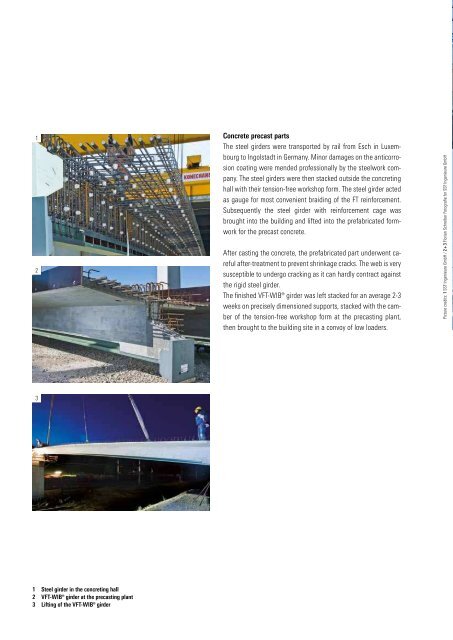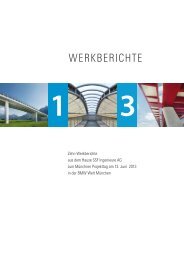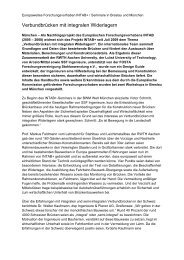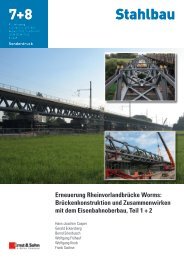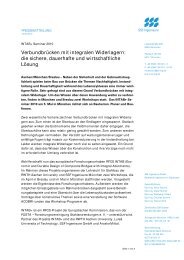Vigaun Bridge (PDF) - SSF Ingenieure
Vigaun Bridge (PDF) - SSF Ingenieure
Vigaun Bridge (PDF) - SSF Ingenieure
You also want an ePaper? Increase the reach of your titles
YUMPU automatically turns print PDFs into web optimized ePapers that Google loves.
1<br />
2<br />
Concrete precast parts<br />
The steel girders were transported by rail from Esch in Luxembourg<br />
to Ingolstadt in Germany. Minor damages on the anticorrosion<br />
coating were mended professionally by the steelwork company.<br />
The steel girders were then stacked outside the concreting<br />
hall with their tension-free workshop form. The steel girder acted<br />
as gauge for most convenient braiding of the FT reinforcement.<br />
Subsequently the steel girder with reinforcement cage was<br />
brought into the building and lifted into the prefabricated formwork<br />
for the precast concrete.<br />
After casting the concrete, the prefabricated part underwent careful<br />
after-treatment to prevent shrinkage cracks. The web is very<br />
susceptible to undergo cracking as it can hardly contract against<br />
the rigid steel girder.<br />
The finished VFT-WIB® girder was left stacked for an average 2-3<br />
weeks on precisely dimensioned supports, stacked with the camber<br />
of the tension-free workshop form at the precasting plant,<br />
then brought to the building site in a convoy of low loaders.<br />
Picture credits: 1 <strong>SSF</strong> <strong>Ingenieure</strong> GmbH / 2 + 3 Florian Schreiber Fotografie for <strong>SSF</strong> <strong>Ingenieure</strong> GmbH<br />
Picture credits: Florian Schreiber Fotografie for <strong>SSF</strong> <strong>Ingenieure</strong> GmbH<br />
3<br />
Construction<br />
The foundations, rising pillars and abutments were constructed<br />
parallel to the VFT-WIB® girders. Short steel girders were concreted<br />
into the working joints to the transversal girder for precise<br />
support of the prefabricated girders.<br />
The Salzburg-Wörgl railway line was closed for 4 hours to lift the<br />
prefabricated girders into position over the track. The girders in<br />
span 3 were fitted on the day before the line was closed and the<br />
truck-mounted crane was then moved into position over the track<br />
for fitting the girders of the middle span and span 1.<br />
After fitting the girders, the remaining gap between the head<br />
plates of the girders was cast over the pillars, the transversal<br />
girder reinforced and concreted. Then the in-situ concrete slab<br />
was added. Following the final jobs of work with caps, surface<br />
and safety barriers, the bridge was opened for traffic in October<br />
2008 after a total construction period of 8 months.<br />
Economic efficiency<br />
The rolled girders including cutting, prefabrication and corrosion<br />
protection amounted to around € 2,100 per tonne free precasting<br />
plant, in spite of the extremely high steel prices prevailing<br />
in spring 2008, thus making them far less expensive than a<br />
comparable welded girder. Production of the entire bridge including<br />
finishing and without road construction work cost € 1,030<br />
net per m² bridge. These are low production costs for a narrow<br />
bridge structure with high substructures.<br />
Together with economic production, the narrow bridge also fits<br />
in well with the surrounding hilly landscape. It can be presumed<br />
that the framework system without bearings, the externally<br />
reinforcement offering very small corrosion protection surfaces<br />
and the sound construction method are likely to entail little<br />
maintenance effort on the bridge.<br />
1 Steel girder in the concreting hall<br />
2 VFT-WIB® girder at the precasting plant<br />
3 Lifting of the VFT-WIB® girder<br />
VFT is a Registered Trade Mark of <strong>SSF</strong> <strong>Ingenieure</strong> GmbH<br />
VFT-WIB is a Registered Trade Mark of <strong>SSF</strong> <strong>Ingenieure</strong> GmbH


